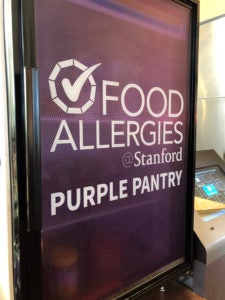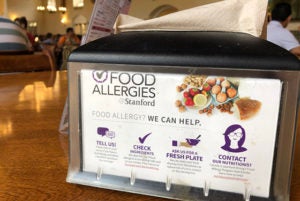Managing food allergies at Stanford

The Food Allergies@Stanford program offers accommodations to support the more than 300 Stanford undergraduates with medically-documented food allergies and special dietary needs. Cassidy Willingham, dining food allergy program nutritionist, answers questions about how students can manage a food allergy while at Stanford.
What does Stanford do to support students with food allergies?
At Residential & Dining Enterprises (R&DE) Stanford Dining, we provide a variety of menu options for students who have food allergies, food restrictions and/or special diets. We’ve partnered with FARE (Food Allergy Research & Education), an organization whose mission is to improve the quality of life and the health of people with food allergies, and we follow their best practices. In addition, our nutritionists review all ingredients, recipes and menus for allergens, train R&DE staff on food allergy accommodations and provide nutrition counseling and education for students to help with managing their dietary needs.
What steps can students themselves take at Stanford?
We strongly encourage students to contact us at nutritionist@stanford.edu for information and support and to register for dining accommodations. We are available to meet with students year round. Students also should feel comfortable talking directly to any member of the R&DE staff. Chefs and dining hall managers are happy to provide information about ingredients and food preparation.

Does Stanford post menu labels so students can easily identify allergens?
Yes. We know that eight allergens—eggs, fish, milk, peanuts, shellfish, soy, tree nuts and wheat—cause 90 percent of allergic reactions. As a result, those top allergens, as well as coconut and sesame, are identified on menu labels posted throughout the dining halls at the point of service. Ingredients are also listed in each dish for students with food allergies or dietary preferences outside of the top allergens. Dishes are designated vegetarian (V), vegan (VGN) and gluten free (GF) to help students navigate their options. Students are encouraged to check the weekly menus, which are posted on Stanford Dining’s Facebook (facebook.com/StanfordDining) page and include notations for allergens.
How can students avoid cross contact?
Stanford Dining offers a fresh plate for students who might be concerned about cross-contact of allergens on the serving line. A student simply lets a dining staff member know what he or she would like to eat from the available options for the day. Using new gloves and clean serving utensils, the staff member will assemble a meal with food from the kitchen that has not come into contact with potential allergens on the serving line.
How about students with highly complex food allergies?
Allergy-friendly meals, made using designated cookware and utensils, are available for those with severe or highly complex food allergies. Meals can be ordered through an online ordering system with at least 24 hours advance notice. But students must be registered with the Food Allergies@Stanford program to use the online ordering

system.
What is available for students who need gluten-free foods?
Gluten-free bread is available in a designated space in every dining hall. Stanford Dining kitchens substitute tamari sauce for soy sauce, so guests who avoid gluten can enjoy a greater selection of entrees. Quinoa, millet and amaranth are among the rotating gluten-free grains. In addition to salad bars filled with seasonal vegetables and legumes, Stern Dining Hall has gluten-free tortillas; Wilbur Dining Hall has gluten-free rice noodles for the pho station; and weekly gluten-free specials are offered for lunch at Florence Moore Dining Hall.
What are the Purple Pantries?
Each campus dining hall has a Purple Pantry, which is a locked mini refrigerator stocked with allergy-friendly and gluten-free breads, rice milk, dairy-free yogurts, condiments and pastries. The largest Purple Pantry, at Arrillaga Family Dining Commons, also offers a variety of cereals, snacks and frozen foods. Again, students must be registered with the Food Allergies@Stanford program to receive a key.
Visit the Food Allergies@Stanford website.
